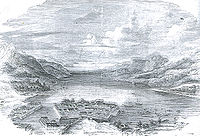
Nagasaki bugyo
Encyclopedia


Tokugawa shogunate
The Tokugawa shogunate, also known as the and the , was a feudal regime of Japan established by Tokugawa Ieyasu and ruled by the shoguns of the Tokugawa family. This period is known as the Edo period and gets its name from the capital city, Edo, which is now called Tokyo, after the name was...
in Edo period
Edo period
The , or , is a division of Japanese history which was ruled by the shoguns of the Tokugawa family, running from 1603 to 1868. The political entity of this period was the Tokugawa shogunate....
Japan. Appointments to this prominent office were usually fudai
Fudai
was a class of daimyo who were hereditary vassals of the Tokugawa in Edo period Japan. It was primarily the fudai who filled the ranks of the Tokugawa administration.-Origins:...
daimyō
Daimyo
is a generic term referring to the powerful territorial lords in pre-modern Japan who ruled most of the country from their vast, hereditary land holdings...
, but this was amongst the senior administrative posts open to those who were not daimyō. Conventional interpretations have construed these Japanese titles as "commissioner" or "overseer" or "governor."
This bakufu tile identifies an official responsible for administration of the port of Nagasaki, including the Chinese and Dutch settlements located there. This bugyō was also responsible for overseeing the port's commercial activities. The numbers of men holding the title concurrently would vary during the years of this period. At any given time, one would normally be in residence at Nagasaki, and the other would be in Edo as part of an alternating pattern.
Other duties of the Nagasaki bugyō included monitoring news and scientific developments in the West as information became available in the course of trade. For example, the Nagasaki City Museum preserves letters from the Dutch opperhoofd
Opperhoofd
Opperhoofd is a Dutch word which literally means 'supreme head'.The Danish equivalent Overhoved, which is derived from a Danish pronunciation of the Dutch word, is also treated here....
to the Nagasaki bugyō about the two-year-long sales negotiations and the purchase price of a portable Dutch astronomical quadrant imported into Japan in 1792, implying that the instrument was seen as important by both the Japanese and the Dutch. The details of the instrument, along with some elaborate drawings, were provided in the Kansei Rekisho (Compendium of the Kansei
Kansei
was a after Tenmei and before Kyōwa. This period spanned the years from January 1789 through February 1801. The reigning emperor was .-Change of era:...
Calendar), which was completed around 1844. The compendium records the names of the instrument’s manufacturers, as inscribed on the telescope and on the pendulum box—G. Hulst van Keulen and J. Marten Kleman (1758–1845). Although that instrument once owned by the Astronomical Office of the shogunal government is now lost, drawings of a quadrant equipped with a telescope (Gensho Kansei-kyo zu) have been reported by the National Astronomical Observatory of Japan
National Astronomical Observatory of Japan
The is an astronomical research organisation comprising several facilities in Japan, as well as an observatory in Hawaii. It was established in 1988 as an amalgamation of three existing research organizations - the Tokyo Astronomical Observatory of the University of Tokyo, International Latitude...
.
Shogunal city
During this period, Nagasaki was designated a "shogunal city." The number of such cities rose from three to eleven under Tokugawa administration.List of Nagasaki bugyō
-
- Ogasawara Tamemune (1603–1604)
- Hasegawa Shigeyoshi (1604–1605)
- Hasegawa Fujihiro (1605–1614)
- Hasegawa Fujimasa (1605–1614)
- Takenaka Umene (1626–1631)
- Mizuno Morinobu (1626–1629)
- Takenaka Shigeyoshi (1629–1634)
- Imamura Masanaga (1633–1634)
- Sakakibara Motonao (1634–1640)
- Kamio Motokatsu (1634–1638)
- Ōkōchi Masakatsu (1638–1640)
- Tsuge Masatoki (1640–1642)
- Baba Toshishige (1642–1650)
- Yamazaki Masanobu (1642–1650)
- Kurokawa Masanao (1650–1665)
- Kaijō Masanobu (1651–1660)
- Ushigome Chūzaemon Shigenori (1671–1681).
- Yamaoka Kagesuke (1687–1694)
- Miyagi Masazumi (1687–1696)
- Niwa Nagamori (1699–1702)
- Ōshima Yoshinari (1699–1703)
- Sakuma Nobunari (1703–1713)
- Hisamatsu Sadamochi (1710–1715)
- Ōoka Kiyosuke (1711–1717)
- Ōmori Tokinaga (1732–1734)
- Hagiwara Yoshimasa (1736–1743)
- Matsunami Heizaemon (1744)
- Kondō Jūzō (1747).
- Ōoka Tadayori (1763–1764)
- Kurihara Morisada (1773–1775)
- Kuze HirotamiKuze Hirotami, also known as ', was a late-18th century Nagasaki bugyō or governor of Nagasaki port, located on southwestern shore of Kyūshū island in the Japanese archipelago. Kuze was one of the Nagasaki bugyō between 1775 and 1784....
(1775–1784). - Tsuge Masakore (1781-17__).
- Tsuchiya Morinao (1783–1784).
- Tsuchiya Masanobu (1784–1785).
- Toda Ujiharu (1784–1786),
- Tsuge Hirotami (1786).
- _________________ (1793).
- Matsudaira YasuhideMatsudaira Yasuhide' was a Japanese daimyo of the late Edo period, who ruled the Tanakura and then Kawagoe Domains. He served as gaikoku bugyō and rōjū in the Tokugawa administration.-Biography:...
(1807–1808) - Tōyama Kagekuni (1812–1816)
- Matsuyama Naoyoshi (1815–1817)
- Kanezawa Chiaki (1816–1818)
- Tsutsui Masanori (1817–1821)
- Izawa Masayoshi (1842–1845).
- Ido Satohiro (1845–1849).
- Mizuno Tadanori (1853–1854, 1857–1858).
- Arao Narimasa (1854–1859).
- Arao Shigemitsu(1854–1859)
- Takahashi Kazunuki (1862).
- Sugiura Katsukiyo (1863)
- Kyōgoku Takaakira (1863)
- Hattori Tsunezumi (1863–1866)
- Asagara Masahiro (1864–1866)
- Kawazu Sukekuni (1867–1868).

